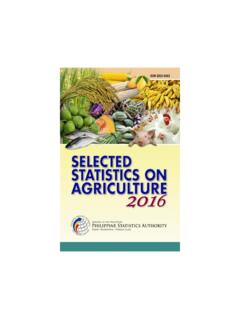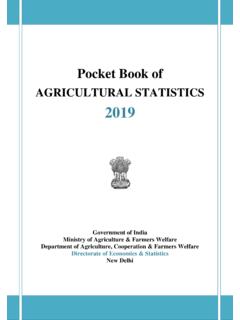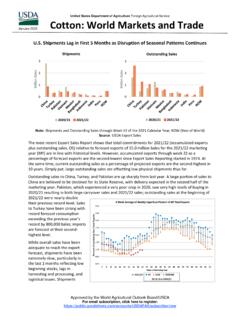Transcription of PHILIPPINE STATISTICS AUTHORITY
1 PHILIPPINE STATISTICS AUTHORITY PHILIPPINE STATISTICS AUTHORITY SELECTED STATISTICS ON AGRICULTURE 2019 PHILIPPINE STATISTICS AUTHORITY REPUBLIC OF THE PHILIPPINES HIS EXCELLENCY PRESIDENT RODRIGO R. DUTERTE PHILIPPINE STATISTICS AUTHORITY CLAIRE DENNIS S. MAPA, Undersecretary National Statistician and Civil Registrar General ROSALINDA P. BAUTISTA Assistant Secretary Deputy National Statistician Sectoral STATISTICS Office ISSN-2012-0362 Selected STATISTICS on Agriculture is a publication of the PHILIPPINE STATISTICS AUTHORITY (PSA). The PSA reserves exclusive right to reproduce this publication in whatever form. Should any portion of this publication be included in a report/article, the title of the publication and the PSA should be cited as the source of the data.
2 The PSA will not be responsible for any information derived from the processing of data contained in this publication. SELECTED STATISTICS ON AGRICULTURE 2019 FOREWORDThe 2019 Selected STATISTICS on Agriculture (SSA) is the 30th issueof the annual statistical report published by the PhilippineStatistics AUTHORITY (PSA). lt provides a five-year data series(2014-2OL8l for selected macroeconomic indicators andagricultural production by subsector and by commodity,including STATISTICS on production costs and returns, price andtrade, and supply utilization accounts. Through this report, thePSA consolidates STATISTICS and indicators that can respond tothe needs of our data 30th issue of SSA can be downloaded from is available in printed the PSA strives to improve its statistical products andservices, we welcome comments and feedback on the contentsand format of this publication,ctAtRE DENNTS S.)
3 MAPA, Statistician and Civil Registrar GeneralQuezon Oty, PhilippinesAugust 2019 PHILIPPINE STATISTICS AUTHORITY PHILIPPINE STATISTICS AUTHORITY ACKNOWLEDGMENT Our appreciation and gratitude go to the following agencies for their cooperation and support in sharing with us their data: Asian Development Bank (ADB), National Meat Inspection Service (NMIS), Bangko Sentral ng Pilipinas (BSP), Department of Budget and Management (DBM), Food and Agriculture Organization (FAO), Fertilizer and Pesticide AUTHORITY (FPA), PHILIPPINE Fiber Industry Development AUTHORITY (PhilFIDA), National Food AUTHORITY (NFA), National Irrigation Administration (NIA), PHILIPPINE Coconut AUTHORITY (PCA), Sugar Regulatory Administration (SRA) and World Bank (WB).
4 Ii PHILIPPINE STATISTICS AUTHORITY TABLE OF CONTENTS iii SELECTED STATISTICS ON AGRICULTURE 2019 Page/sForeword ..iAcknowledgment ..iiTable of Contents ..iiiExplanatory Notes ..ivAn Overvi ew of the Phi l i ppi ne agricultural Economy ..1 Sel ected Macroeconomi c and Agriculture Sector STATISTICS ..4 Crops Subsector STATISTICS ..8Li ves tock & Poul try Subs ector STATISTICS ..18 Fisheries Subsector STATISTICS ..24 production Costs and Returns ..30 Price STATISTICS ..34 Agri cul tural Forei gn Trade STATISTICS ..42 Supply Utilization Accounts ..54 PHILIPPINE STATISTICS AUTHORITY EXPLANATORY NOTES of basic data are indicated at the bottom of each table. otherwise indicated, year refers to calendar year. a rule, figures from source publications were copied to the extent possible.
5 In some instances, however, figures were rounded-off or combined. may not add up to the totals due to rounding off. per hectare is derived prior to rounding-off the data on production and hectarage. following symbols and abbreviations are used in the tables: - - - Data not yet available - None R Revised P Preliminary mt Metric Ton ha(s) Hectare/s kg Kilogram GNI Gross National Income GVA Gross Value Added GDP Gross Domestic Product FOB Freight on Board CIF Cost Insurance Freight NFD Net Food Disposable CPH Census of Population and Housing iv PHILIPPINE STATISTICS AUTHORITY SELECTED STATISTICS ON AGRICULTURE 2019 AN OVERVIEW OF THE PHILIPPINE agricultural ECONOMY Economic country s Gross Domestic Product (GDP) increased by percent in 2018.
6 The Gross Value Added (GVA) in the agriculture and fishing sector recorded a percent increment during the year. This sector contributed percent to the GDP. production Performance in Agriculture. Agriculture grew by percent in 2018. Gains in production were noted in livestock and poultry while declines in outputs were registered in crops and fisheries. Crops registered a percent reduction in output. Palay and corn suffered as production dropped by percent and percent, respectively. Sugarcane production declined by percent. Coconut posted a percent growth in output. Increases in production were noted in the other crops such as banana, pineapple, peanut, mongo, tomato, eggplant, abaca and rubber.
7 Meanwhile, downtrends in outputs continued in coffee, mango, tobacco, cabbage and calamansi. Livestock production increased by percent in 2018. Hog and dairy came up with corresponding output gains of percent and percent. In contrast, production of carabao, cattle and goat went down by percent, percent and percent, respectively. Poultry recorded a percent increment in production . Chicken production maintained its uptrend of percent while that of duck continuously declined by percent. Egg production increased by percent for chicken and by percent for duck. Fisheries recorded a percent reduction in output. Downtrends in production were noted among the major species such as roundscad, yellowfin tuna, milkfish and tiger prawn.
8 Prices. In 2018, the prices received by farmers for their palay production were higher by an average of percent than the previous year s record. Farmgate prices went up by percent for white corngrain and by percent for yellow corngrain. All livestock commodities exhibited increases in prices in 2018. Goat posted the highest price hike at percent. For poultry, farmgate prices of chicken (broiler) grew by percent while that of duck went up by percent in 2018. 1 PHILIPPINE STATISTICS AUTHORITY On the other hand, the prices paid by consumers for food and non-alcoholic beverages increased by an average of percent. agricultural Trade.
9 The country s earnings from agricultural exports, which accounted for percent of the total exports revenue, declined by percent in 2018. Fresh banana, coconut oil and tuna were the top agricultural export products. These contributed percent to the total value of agricultural exports. The major export destinations were still China and Japan for fresh banana, United States of America (USA) and the Netherlands for coconut oil, and United Kingdom and Japan for tuna. The 2018 expenditures for agricultural imports expanded by percent. It shared percent to the country s total value of imports. Wheat (including spelt) and meslin, soyabean oil/cake meal, and milk and cream and cream products recorded higher payments than their import values in the previous year.
10 Collectively, these shared percent to the total value of agricultural imports. USA was the top supplier of wheat (including spelt) and meslin and soyabean oil/cake meal. The bulk of the imports of milk and cream and products were sourced from New Zealand. The Philippines continued to record a negative agricultural trade balance. While it sustained an agricultural trade surplus with Japan, it remained to register trade deficits with the other major trading partners such as Australia, ASEAN countries and the European Union. After a series of trade deficits, the country had trade surplus with the USA in 2018. Employment. In 2018, a total of million persons were in the country s labor force, of which percent were employed. The agriculture sector employed million persons and it represented a share of percent to the national employment.














